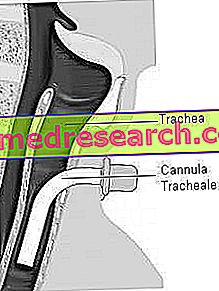
Types of tracheotomy?
The tracheotomy is a delicate surgical maneuver performed to construct a direct (and reversible) respiratory communication between the external environment and the tracheal lumen. This passage, created by making an incision of skin and tracheal wall, is made possible through the insertion of a special tracheal cannula.
Similar interventions are practiced in all the occasions in which the patient complains of serious respiratory difficulties, caused for example by inflammations, neoplasms, accumulations of mucus in the trachea, chronic respiratory insufficiency or other.
There are essentially two types of tracheotomy:
- Emergency intervention, which must be performed immediately to safeguard the patient's life. To limit the execution times, the emergency tracheotomy can also be performed in the aisle.
- Election operation, which requires longer intervention times and is almost always carried out in the operating theater.
Emergency tracheotomy and elective tracheotomy
EMERGENCY TRACHEOTOMY (or cricothyrotomy)
It requires extremely rapid execution times to save the patient's life: the "time" factor therefore strongly influences this type of tracheotomy.
In such circumstances, the doctor cuts the trachea by making a longitudinal incision through the cricothyroid membrane (for this reason, the emergency tracheotomy is also called cricothyrotomy). Then proceed by inserting a needle-cannula, in turn connected with a special oxygen bag.
Did you know that ...
In tracheotomy, the use of the cannula is essential to avoid the collapse of the soft tissues
The operation is performed under local anesthesia (injection of local anesthetic through the cricothyroid membrane), since general analgesia would require excessively long times.
ELECTIVE TRACHEOTOMY
It is performed in the operating room in longer times than in the previous case. After slight general (usually) and / or local anesthesia (less frequently), the surgeon performs an incision on the patient's skin, at the level of the lower part of the neck (in the area between the Adam's apple and the upper part of the sternum).

Curiosity
The incision of the tracheal rings can be performed differently. The engraving methods can in fact be: vertical, horizontal, H-shaped, inverted H or "lower hinge".
An oxygen bag or ventilator can be connected to the cannula to facilitate oxygen transport to the lungs. To maintain the tube in the correct position, stitches are performed.
Watch the video
X Watch the video on youtubePercutaneous tracheotomy
It is a relatively recent variant of tracheotomy which involves the use of dilating instruments to enlarge the tissue tracheal bundles rather than dissecting them.
Percutaneous tracheotomy, which creates a temporary respiratory passage, is indicated for patients requiring prolonged artificial respiratory assistance. This is a very rapid surgical maneuver, therefore very used in emergency situations.
There are numerous variants of percutaneous tracheotomy. Most often, a special connecting cannula is used, which is introduced between the cricoid cartilage and the first tracheal ring; often, the cannula is inserted directly into the trachea, therefore lower, between the tracheal rings.
Compared to classical tracheotomy, percutaneous involves fewer risks and post-surgery complications, both in infectious and traumatic terms.
However, the choice of operative mode (standard or percutaneous tracheotomy) is exclusively medical.
Healing of the tracheostoma (hole)
We have seen that the cannula used in the tracheotomy operation is indispensable both to avoid the collapse of the soft tissues (which connect the various cartilaginous rings of the trachea), and to facilitate / facilitate the patient's breathing. Having said this, it is understood that the extraction of the aforementioned connecting tube from the trachea determines the closure of the skin-trachea passage (called stoma or tracheostoma). The healing time (closure) of the stoma is strongly influenced by the time in which the cannula has been positioned: the longer the tube is in place, the longer the healing time will be. While, in a dated tracheotomy, the passage skin-trachea tends to remain open for quite long times, in a recent tracheotomy the collapse of the connective tissue is almost immediate.
Curiosity
In addition to the stationing period of the tracheal cannula, the closure times of the stoma are influenced by more than one factor:
- Respiratory pressure changes
- Thickening of connective tissue (induced by inflammation produced during surgery)
If, after the collapse of the stoma, natural respiration is completely restored, we are witnessing a physiological reparative process that favors the total healing and healing of the incision: in such circumstances, the stoma is definitively closed again.
When it is desired to restore natural breathing, it is therefore sufficient to extract the tracheal cannula and immediately medicate the cutaneous hole created during the tracheotomy with a sterile medicated gauze, indispensable for speeding up healing times and minimizing the risk of infections.
The surgical mending of the stoma following a tracheotomy should not be considered a method of first choice to promote healing: in such situations, in fact, the patient may encounter complications and problems after surgery of various kinds and entities, such as in particular stenosis (narrowing) tracheal.



